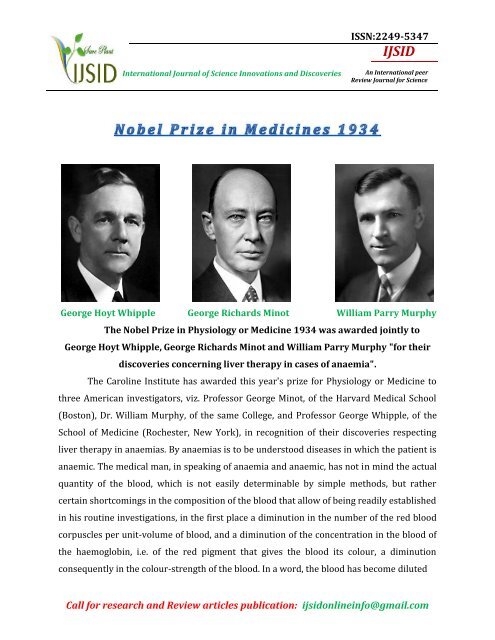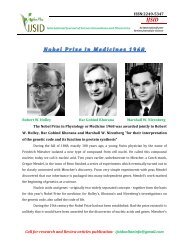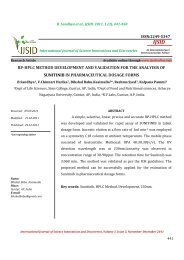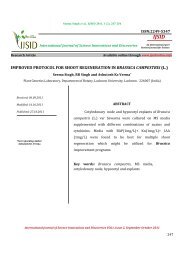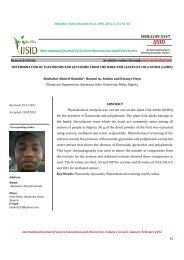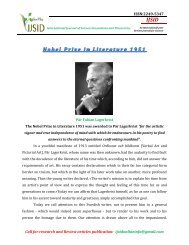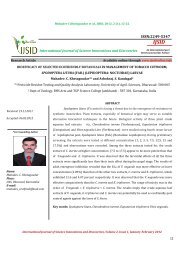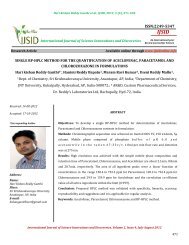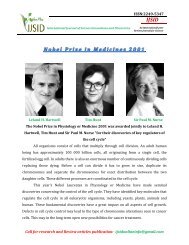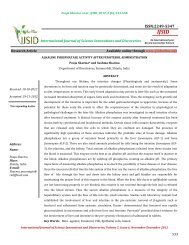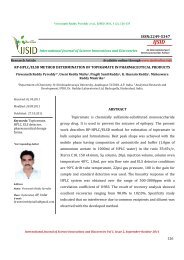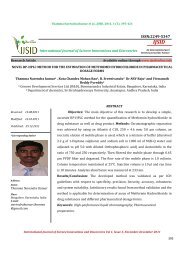The Nobel Prize in Physiology or Medicine 1934 ... - Ijsidonline.info
The Nobel Prize in Physiology or Medicine 1934 ... - Ijsidonline.info
The Nobel Prize in Physiology or Medicine 1934 ... - Ijsidonline.info
Create successful ePaper yourself
Turn your PDF publications into a flip-book with our unique Google optimized e-Paper software.
ISSN:2249-5347IJSIDInternational Journal of Science Innovations and DiscoveriesAn International peerReview Journal f<strong>or</strong> ScienceGe<strong>or</strong>ge Hoyt Whipple Ge<strong>or</strong>ge Richards M<strong>in</strong>ot William Parry Murphy<strong>The</strong> <strong>Nobel</strong> <strong>Prize</strong> <strong>in</strong> <strong>Physiology</strong> <strong>or</strong> Medic<strong>in</strong>e <strong>1934</strong> was awarded jo<strong>in</strong>tly toGe<strong>or</strong>ge Hoyt Whipple, Ge<strong>or</strong>ge Richards M<strong>in</strong>ot and William Parry Murphy "f<strong>or</strong> theirdiscoveries concern<strong>in</strong>g liver therapy <strong>in</strong> cases of anaemia".<strong>The</strong> Carol<strong>in</strong>e Institute has awarded this year's prize f<strong>or</strong> <strong>Physiology</strong> <strong>or</strong> Medic<strong>in</strong>e tothree American <strong>in</strong>vestigat<strong>or</strong>s, viz. Profess<strong>or</strong> Ge<strong>or</strong>ge M<strong>in</strong>ot, of the Harvard Medical School(Boston), Dr. William Murphy, of the same College, and Profess<strong>or</strong> Ge<strong>or</strong>ge Whipple, of theSchool of Medic<strong>in</strong>e (Rochester, New Y<strong>or</strong>k), <strong>in</strong> recognition of their discoveries respect<strong>in</strong>gliver therapy <strong>in</strong> anaemias. By anaemias is to be understood diseases <strong>in</strong> which the patient isanaemic. <strong>The</strong> medical man, <strong>in</strong> speak<strong>in</strong>g of anaemia and anaemic, has not <strong>in</strong> m<strong>in</strong>d the actualquantity of the blood, which is not easily determ<strong>in</strong>able by simple methods, but rathercerta<strong>in</strong> sh<strong>or</strong>tcom<strong>in</strong>gs <strong>in</strong> the composition of the blood that allow of be<strong>in</strong>g readily established<strong>in</strong> his rout<strong>in</strong>e <strong>in</strong>vestigations, <strong>in</strong> the first place a dim<strong>in</strong>ution <strong>in</strong> the number of the red bloodc<strong>or</strong>puscles per unit-volume of blood, and a dim<strong>in</strong>ution of the concentration <strong>in</strong> the blood ofthe haemoglob<strong>in</strong>, i.e. of the red pigment that gives the blood its colour, a dim<strong>in</strong>utionconsequently <strong>in</strong> the colour-strength of the blood. In a w<strong>or</strong>d, the blood has become dilutedCall f<strong>or</strong> research and Review articles publication: ijsidonl<strong>in</strong>e<strong>in</strong>fo@gmail.com
ISSN:2249-5347IJSIDInternational Journal of Science Innovations and DiscoveriesAn International peerReview Journal f<strong>or</strong> ScienceOf the three prize-w<strong>in</strong>ners, it was Whipple who first occupied himself with the<strong>in</strong>vestigations f<strong>or</strong> which the prize has now been awarded. He began <strong>in</strong> 1920 to study the<strong>in</strong>fluence of food on blood regeneration, the re-build<strong>in</strong>g-up of the blood, <strong>in</strong> cases ofanaemia consequent upon loss of blood. F<strong>or</strong> the fact is that anaemia <strong>in</strong> the sense justmentioned also arises as a consequence of a loss of blood. <strong>The</strong> dim<strong>in</strong>ution <strong>in</strong> the quantity ofthe blood is made up f<strong>or</strong>, comparatively quickly, by an <strong>in</strong>flux of water from the tissues, thatis to say by a process of dilution, of which the consequence is a reduction <strong>in</strong> the number ofthe red blood c<strong>or</strong>puscles and the haemoglob<strong>in</strong> per unit of volume - thus a case of anaemia.That be<strong>in</strong>g so, Whipple started to study the effect that various food substances might haveon the process of the regeneration of the blood. It was known bef<strong>or</strong>ehand, it is true, that aplentiful supply of food is an imp<strong>or</strong>tant fact<strong>or</strong> <strong>in</strong> rest<strong>or</strong><strong>in</strong>g the blood to a n<strong>or</strong>malconsistency, but it was not known that <strong>in</strong>dependent of the quantity of the food and of itscal<strong>or</strong>ic value, different articles of food played differ<strong>in</strong>g parts. <strong>The</strong> method Whipple adopted<strong>in</strong> his experiments was to bleed dogs that are to say to withdraw from them a certa<strong>in</strong>quantity of their blood, supply<strong>in</strong>g them afterwards with food of various k<strong>in</strong>ds. By thatmethod he discovered that certa<strong>in</strong> k<strong>in</strong>ds of food were considerably superi<strong>or</strong> to others,<strong>in</strong>asmuch as they gave stimulus to a m<strong>or</strong>e vig<strong>or</strong>ous ref<strong>or</strong>mation of blood, that is to saystimulated the bone marrow - <strong>in</strong> which the blood c<strong>or</strong>puscles are produced - to a m<strong>or</strong>evig<strong>or</strong>ous manufacture of red blood c<strong>or</strong>puscles. It was first and f<strong>or</strong>emost liver, then kidney,then meat, and next after that certa<strong>in</strong> vegetable articles of food too, e.g. apricots, thatproved <strong>in</strong> an especial degree to have a strongly stimulat<strong>in</strong>g effect. Whipple's experimentswere planned exceed<strong>in</strong>gly well and carried out very accurately, and consequently theirresults can lay claim to absolute reliability. <strong>The</strong>se <strong>in</strong>vestigations and results of Whipple'sgave M<strong>in</strong>ot and Murphy the idea, that an experiment could be made to see whetherfavourable results might not also be obta<strong>in</strong>ed <strong>in</strong> the case of pernicious anaemia, an anaemiaof quite a different type, by mak<strong>in</strong>g use of foods of the k<strong>in</strong>d that Whipple had found to yieldfavourable results <strong>in</strong> his experiments regard<strong>in</strong>g anaemia from loss of blood.Call f<strong>or</strong> research and Review articles publication: ijsidonl<strong>in</strong>e<strong>in</strong>fo@gmail.com
ISSN:2249-5347IJSIDInternational Journal of Science Innovations and DiscoveriesAn International peerReview Journal f<strong>or</strong> ScienceBef<strong>or</strong>e enter<strong>in</strong>g upon a discussion of M<strong>in</strong>ot's and Murphy's <strong>in</strong>vestigations <strong>in</strong> detail, Ipropose to say a little about pernicious anaemia. As the name tells us, it is a fateful disease,which, previous to the labours of our prize-w<strong>in</strong>ners, almost <strong>in</strong>variably, with only very fewexceptions, ended fatally <strong>in</strong> the course of a few years, <strong>or</strong> <strong>in</strong> a still sh<strong>or</strong>ter time, a fewmonths. Its cause is not known. It customarily makes its appearance <strong>in</strong> middle-agedpersons, who lose colour, feel tired, and ultimately consult a doct<strong>or</strong>, who establishes thefact that their red blood c<strong>or</strong>puscles have become reduced <strong>in</strong> number from the n<strong>or</strong>malfigure of about five million per mm 3 to considerably lower values, e.g. one million per mm 3 ,<strong>or</strong> to still less, eight, seven <strong>or</strong> six hundred thousand per mm 3 , and that the colour-strengthof the blood has also dim<strong>in</strong>ished, though as a rule not <strong>in</strong> the same high degree as thenumber of the red blood c<strong>or</strong>puscles. M<strong>or</strong>eover, on exam<strong>in</strong><strong>in</strong>g the blood microscopically, the<strong>in</strong>vestigat<strong>or</strong> f<strong>in</strong>ds that the red blood c<strong>or</strong>puscles <strong>in</strong> it are very different to n<strong>or</strong>mal red bloodc<strong>or</strong>puscles. <strong>The</strong> latter are all alike <strong>in</strong> size and <strong>in</strong> f<strong>or</strong>m, whereas <strong>in</strong> pernicious anaemia thereare to be noticed blood c<strong>or</strong>puscles of a great variety of sizes, some considerably larger thann<strong>or</strong>mal and some small ones; and their shapes vary too. <strong>The</strong>y are diseased <strong>or</strong> immaturef<strong>or</strong>ms of red blood c<strong>or</strong>puscles. Hence what the bone marrow has supplied to the blood isnot of a completely satisfact<strong>or</strong>y make <strong>or</strong> consistency. <strong>The</strong> course of the disease iscustomarily a cyclical one, periods of specially severe anaemia alternat<strong>in</strong>g with periodswhen the composition of the blood is m<strong>or</strong>e n<strong>or</strong>mal. <strong>The</strong> circumstance that the disease itselfis subject to variations, show<strong>in</strong>g now improvement, now relapses, renders it of course verymuch m<strong>or</strong>e difficult to determ<strong>in</strong>e the actual effect produced by any treatment adm<strong>in</strong>isteredto the patient. Previous to the results of M<strong>in</strong>ot's and Murphy's experiments the pr<strong>in</strong>cipalmode of treatment adopted, and one that was practised all over the w<strong>or</strong>ld, was the giv<strong>in</strong>g oflarge doses of arsenic, while <strong>in</strong> serious cases it was also customary sometimes to res<strong>or</strong>t tosplenectomy, that is to say to removal of the spleen by an operation, <strong>or</strong> to bloodtransfusion, i.e. the transfer to the patient of blood from another person, a method that isstill to be recommended at a critical stage <strong>in</strong> severe cases. Hence it was quite a strangeconception, and one ly<strong>in</strong>g remote from the customary beat, that came <strong>in</strong>to the m<strong>in</strong>ds ofCall f<strong>or</strong> research and Review articles publication: ijsidonl<strong>in</strong>e<strong>in</strong>fo@gmail.com
ISSN:2249-5347IJSIDInternational Journal of Science Innovations and DiscoveriesAn International peerReview Journal f<strong>or</strong> ScienceM<strong>in</strong>ot and Murphy, when they bethought themselves, that it might possibly be feasible totreat a patient suffer<strong>in</strong>g from this disease by adm<strong>in</strong>ister<strong>in</strong>g food to him. It was an idea, <strong>in</strong>fact, that had never been conceived of, up to that time. A consultation of the textbooks withregard to the matter, f<strong>or</strong> <strong>in</strong>stance, will show us that very little attention was paid to thediet. Some items of good advice are to be found given, <strong>in</strong>deed, respect<strong>in</strong>g the patient's diet<strong>in</strong> pernicious anaemia, not as an <strong>in</strong>tegral part of the treatment though, but rather as anelement <strong>in</strong> the nurs<strong>in</strong>g required <strong>in</strong> general. <strong>The</strong>re was, however, one exception to thatuniversal rule, f<strong>or</strong> <strong>in</strong> one spot <strong>in</strong> the w<strong>or</strong>ld the idea had really arisen and been put <strong>in</strong>topractice. To that I shall return later on.<strong>The</strong> first w<strong>or</strong>k published by M<strong>in</strong>ot and Murphy <strong>in</strong> regard to this question dates from1926. It was a sh<strong>or</strong>t paper of n<strong>in</strong>eteen pages, entitled: «Treatment of Pernicious Anaemiawith a Special Diet». No mention here of a liver diet, but of a special diet, the special dietthey had <strong>in</strong> view be<strong>in</strong>g one derived from Whipple's <strong>in</strong>vestigations, based on Whipple's diet,consist<strong>in</strong>g of liver, kidney, meat and vegetables, the last two also <strong>in</strong> large quantities. Asrep<strong>or</strong>ts of observations began to come flood<strong>in</strong>g <strong>in</strong>, show<strong>in</strong>g that results had really beenachieved by the application of the diet, there occurred by degrees a variation <strong>in</strong> thecomposition of the dietary <strong>in</strong> favour of liver, that food substance which, acc<strong>or</strong>d<strong>in</strong>g to theshow<strong>in</strong>g of Whipple's <strong>in</strong>vestigations, had the strongest stimulat<strong>in</strong>g effect upon theerythropoietic, red-c<strong>or</strong>puscle f<strong>or</strong>m<strong>in</strong>g function of the bone marrow. In their laterpublications we see, m<strong>or</strong>eover, that they employ the designation: «a diet rich <strong>in</strong> liver».Hence their diet became m<strong>or</strong>e and m<strong>or</strong>e preponderat<strong>in</strong>gly a liver diet. <strong>The</strong>re were, it isclear, great difficulties <strong>in</strong> the way to prevent their arriv<strong>in</strong>g at any real discovery <strong>in</strong> thisregard, f<strong>or</strong> the fact is, as we know, that <strong>in</strong> <strong>or</strong>der to be able to achieve any palpable resultsfrom a liver diet, it is requisite f<strong>or</strong> the patient to have liver adm<strong>in</strong>istered <strong>in</strong> veryconsiderable quantities every day, <strong>in</strong> quantities runn<strong>in</strong>g to three, four, five, <strong>or</strong> six hundredgrams, <strong>or</strong> even still m<strong>or</strong>e, per diem - consequently, <strong>in</strong> the twenty-four hours, upwards ofhalf a kilogram of liver, either <strong>in</strong> a raw state <strong>or</strong> <strong>in</strong> some cooked f<strong>or</strong>m. We can understandwhat obstacles that presented f<strong>or</strong> the successful issue of the <strong>in</strong>quiry, s<strong>in</strong>ce such quantitiesCall f<strong>or</strong> research and Review articles publication: ijsidonl<strong>in</strong>e<strong>in</strong>fo@gmail.com
ISSN:2249-5347IJSIDInternational Journal of Science Innovations and DiscoveriesAn International peerReview Journal f<strong>or</strong> Scienceof liver seemed very outrageous at that juncture, when there were no particularly strongreasons f<strong>or</strong> expect<strong>in</strong>g that the diet would have any imp<strong>or</strong>tant <strong>in</strong>fluence on a sufferer frompernicious anaemia. <strong>The</strong> op<strong>in</strong>ion held respect<strong>in</strong>g pernicious anaemia was, that it was soessentially different <strong>in</strong> nature to the blood-loss anaemia, that there did not exist, from atherapeutic po<strong>in</strong>t of view, any real reason f<strong>or</strong> comb<strong>in</strong><strong>in</strong>g them together at all. Asconsequently there was noth<strong>in</strong>g that could with any degree of certa<strong>in</strong>ty be expected t<strong>or</strong>esult from the application of the diet <strong>in</strong> question, and as the method of treatmentdemanded such unreasonably large quantities, it is clear that the experimenters must ofnecessity have been possessed of an extra<strong>or</strong>d<strong>in</strong>ary measure of far-sightedness, anextra<strong>or</strong>d<strong>in</strong>ary degree of energy and an extra<strong>or</strong>d<strong>in</strong>arily clear grasp of all the circumstancesof the case, as they were enabled to succeed <strong>in</strong> <strong>in</strong>duc<strong>in</strong>g the patients to submit to such aregimen notwithstand<strong>in</strong>g its disagreeableness. If M<strong>in</strong>ot and Murphy had not been imbuedwith such an irresistible urge to br<strong>in</strong>g matters to a head, so to say, their discovery wouldnever have been achieved. It was found, however, that, on the diet be<strong>in</strong>g putcontemp<strong>or</strong>aneously to the test at a large number of hospitals <strong>in</strong> the United States, resultswere actually obta<strong>in</strong>ed from the treatment that were astonish<strong>in</strong>g, show<strong>in</strong>g a m<strong>or</strong>e rapidimprovement and blood f<strong>or</strong>mation, i.e. a m<strong>or</strong>e complete rest<strong>or</strong>ation to n<strong>or</strong>mal conditions,than had been seen to result from any other methods of treatment. It was also by degreesobserved that, when once they had recovered a n<strong>or</strong>mal state of the blood, the patientsrema<strong>in</strong>ed well <strong>in</strong> health, which had not been the case with the methods previously applied,f<strong>or</strong> with them, even <strong>in</strong> <strong>in</strong>stances where very considerable improvement occurred, there hadbeen the periodic relapses, which, as I mentioned bef<strong>or</strong>e, are a characteristic feature of thedisease. No sooner had these results been achieved <strong>in</strong> America, and been made public, thanliver diet began to be tested <strong>in</strong> all parts of the w<strong>or</strong>ld as a cure f<strong>or</strong> pernicious anaemia, andfrom all quarters there came rep<strong>or</strong>ts of the same experiences as to results. Fromeverywhere confirmation came of M<strong>in</strong>ot's and Murphy's observations be<strong>in</strong>g c<strong>or</strong>rect.<strong>The</strong> success of the treatment, i.e. that by adm<strong>in</strong>ister<strong>in</strong>g liver one couldactually secure the disappearance of the symptoms of pernicious anaemia, meantCall f<strong>or</strong> research and Review articles publication: ijsidonl<strong>in</strong>e<strong>in</strong>fo@gmail.com
ISSN:2249-5347IJSIDInternational Journal of Science Innovations and DiscoveriesAn International peerReview Journal f<strong>or</strong> Sciencenot only a great therapeutic triumph, but also a reversal of the the<strong>or</strong>y up to thenheld respect<strong>in</strong>g the nature of the disease. <strong>The</strong> f<strong>or</strong>mer idea had been, as a fact, thatthe essential po<strong>in</strong>t <strong>in</strong> the conditions predispos<strong>in</strong>g to pernicious anaemia was thepresence <strong>in</strong> the <strong>or</strong>ganism of a poisonous agent, a poison aris<strong>in</strong>g <strong>in</strong> one way <strong>or</strong>another <strong>or</strong> <strong>or</strong>ig<strong>in</strong>at<strong>in</strong>g from one quarter <strong>or</strong> another - ideas respect<strong>in</strong>g that po<strong>in</strong>twere divergent, but <strong>in</strong> general there was agreement that there must be some poisonthat <strong>in</strong>terfered with the proper function<strong>in</strong>g of the bone marrow, entail<strong>in</strong>g as aconsequence the production on its part of diseased, imperfect, immature red bloodc<strong>or</strong>puscles. <strong>The</strong> discovery that the disease could be cured by the sufferer from itbe<strong>in</strong>g given a diet of liver, led scientists, very naturally, at once to query <strong>in</strong> theirm<strong>in</strong>ds whether the the<strong>or</strong>y regard<strong>in</strong>g the disease that had up to then been prevalentcould be c<strong>or</strong>rect. Reflection upon the matter must as a matter of course lead to theconclusion, that it was not probable that the presence of a supposedpoisonoussubstance could be the cause of the disease, it be<strong>in</strong>g seem<strong>in</strong>gly due rather totheabsence of a substance that was requisite f<strong>or</strong> a satisfact<strong>or</strong>y production of redblood c<strong>or</strong>puscles, a substance that must be present <strong>in</strong> liver, see<strong>in</strong>g that the patient'scondition became n<strong>or</strong>mal when liver was supplied as a food. In fact, a new functionof the liver had thus been revealed. It is <strong>in</strong>terest<strong>in</strong>g to observe the reaction ofmedical science to this altered aspect of the matter. <strong>The</strong>re exist certa<strong>in</strong>representatives of quasi-medical <strong>or</strong> medico-religious bodies, who are <strong>in</strong> the habit ofalleg<strong>in</strong>g that medical science is a species of religion <strong>or</strong> philosophical system, basedupon irrefrangible tenets that do not allow of alteration <strong>or</strong> modification. That mayhave been so some hundreds of years ago, but <strong>in</strong> our days it is so no longer. <strong>The</strong>framew<strong>or</strong>k of medical science, as of other natural sciences, is a body of facts andupon them medical the<strong>or</strong>ies are based and built up. When a new and imp<strong>or</strong>tant facthas been established, the effect is somewhat like that of a bomb fall<strong>in</strong>g to earth:those the<strong>or</strong>ies that do not admit of be<strong>in</strong>g reconciled with it are exploded, be<strong>in</strong>greplaced at once by others that can be brought <strong>in</strong>to better harmony with the newlyCall f<strong>or</strong> research and Review articles publication: ijsidonl<strong>in</strong>e<strong>in</strong>fo@gmail.com
ISSN:2249-5347IJSIDInternational Journal of Science Innovations and DiscoveriesAn International peerReview Journal f<strong>or</strong> Scienceacquired item of factual knowledge. And that has been the case <strong>in</strong> the present<strong>in</strong>stance.With a view to aff<strong>or</strong>d<strong>in</strong>g a background aga<strong>in</strong>st which the discoveries of theprize-w<strong>in</strong>ners may stand out <strong>in</strong> stronger relief, I propose to say a few w<strong>or</strong>ds as tothe function of the liver <strong>in</strong> general. We are all aware that the function of the liver isto secrete bile, to be discharged <strong>in</strong>to the bowel. As is well known, the bile is of greatimp<strong>or</strong>tance <strong>in</strong> aid<strong>in</strong>g the process of digestion. This function of the liver is termed itsexternal secretion, its products by degrees reach<strong>in</strong>g the surface of the body. Besidesthat, however, the liver has other functions; it has f<strong>or</strong> <strong>in</strong>stance also a so-termed<strong>in</strong>ternal secretion. <strong>The</strong> first fact respect<strong>in</strong>g an <strong>in</strong>ternal secretion that science wasable to reveal to mank<strong>in</strong>d b<strong>or</strong>e reference actually to the liver, be<strong>in</strong>g the discovery,made <strong>in</strong> 1855 by the great French physiologist Claude Bernard, of the liver'sglycogenic function, i.e. of the imp<strong>or</strong>tant part played by the liver <strong>in</strong> the metabolismof sugar <strong>in</strong> the body. On demand the liver supplies the sugar that the body requiresf<strong>or</strong> its n<strong>or</strong>mal function<strong>in</strong>g. Claude Bernard gave that process the name of «unesécrétion <strong>in</strong>terne», thereby creat<strong>in</strong>g the term: «<strong>in</strong>ternal secretion», of which we hearso much at the present day. S<strong>in</strong>ce his time the the<strong>or</strong>y that he first enunciated hasbeen built up and amplified very materially. Thus, it is known now, respect<strong>in</strong>g anumber of glandular <strong>or</strong>gans, that, <strong>in</strong> addition to any external secretion that they maybe capable of, they also possess an <strong>in</strong>ternal secretion, that they consequentlymanufacture products that are delivered directly <strong>in</strong>to the blood, and which aresubsequently conveyed via the blood vessels, to remote parts of the body, where <strong>in</strong>other <strong>or</strong>gans they give rise to impulses, accomplish effects, that are of the verygreatest, <strong>in</strong>deed often of a vital, imp<strong>or</strong>tance f<strong>or</strong> the body. To those products, whichthe <strong>in</strong>ternal secretion supplies, the English physiologist Starl<strong>in</strong>g has given the nameof h<strong>or</strong>mones. We are now acqua<strong>in</strong>ted with a very considerable number ofh<strong>or</strong>mones. Time, however, does not admit of my enter<strong>in</strong>g <strong>in</strong>to the subject further; Iwill only call attention <strong>in</strong> pass<strong>in</strong>g to the latterly so much discussed sexual h<strong>or</strong>mones,Call f<strong>or</strong> research and Review articles publication: ijsidonl<strong>in</strong>e<strong>in</strong>fo@gmail.com
ISSN:2249-5347IJSIDInternational Journal of Science Innovations and DiscoveriesAn International peerReview Journal f<strong>or</strong> Sciencethose h<strong>or</strong>mones, that is to say, that regulate the sexual functions, as to which <strong>in</strong>recent years especially Profess<strong>or</strong> Zondek has made such fundamental <strong>in</strong>vestigations.Further, I may mention <strong>in</strong>sul<strong>in</strong>, familiar to us all, a pancreas h<strong>or</strong>mone, whichmedical men make use of <strong>in</strong> the treatment of diabetes. When the pancreas itself is<strong>in</strong>capable of produc<strong>in</strong>g this h<strong>or</strong>mone, which is an essential requisite of the body,diabetes establishes itself. If under those circumstances the h<strong>or</strong>mone is supplied tothe body by the <strong>in</strong>jection of <strong>in</strong>sul<strong>in</strong>, derived from the pancreas of some animal, thesymptoms of the disease can be kept away. This method of treatment, whichconsists of mak<strong>in</strong>g the patient, <strong>in</strong> whose body some <strong>or</strong>gan is not function<strong>in</strong>gsatisfact<strong>or</strong>ily, consume p<strong>or</strong>tions of the said <strong>or</strong>gan, <strong>or</strong> abs<strong>or</strong>b by <strong>in</strong>jection,preparations of the said <strong>or</strong>gan, is termed <strong>or</strong>ganotherapy. Another name issubstitutional <strong>or</strong> replacement therapy, s<strong>in</strong>ce the method consists <strong>in</strong> mak<strong>in</strong>gsubstitution f<strong>or</strong>, <strong>or</strong> replac<strong>in</strong>g, the production that is want<strong>in</strong>g by supplies fromoutside. That type of treatment is not so absolutely new as many people may th<strong>in</strong>k.Thus, we may recall that a French physiologist, Brown-Séquard, as long ago as 1889,carried out <strong>in</strong>vestigations, which aroused great astonishment at the time, as to theeffect of an <strong>in</strong>jection <strong>in</strong>to the body of testicular juice, got from the male genitalglands. He gave himself <strong>in</strong>jections of testicular juice and observed considerablerejuvenat<strong>in</strong>g effects both physically and mentally. That constituted the firstachievement <strong>in</strong> the direction <strong>in</strong> question that science accomplished. Hence, it isBrown-Séquard who laid the foundation of <strong>or</strong>ganotherapy, and the rejuvenationtreatments that we hear so much about at the present time, had f<strong>or</strong>erunners at anearlier date. In this particular case, as <strong>in</strong> general <strong>in</strong> the field of medic<strong>in</strong>e, it is seenthat, by delv<strong>in</strong>g <strong>in</strong>to the ancient rec<strong>or</strong>ds of the cultural achievements of the past, wemay discover the nucleus of many of the methods that attract so much attention <strong>in</strong>our own times as novel and epoch-mak<strong>in</strong>g. If we study Ebers, the papyrus of theancient Egyptians, a venerable documentary rec<strong>or</strong>d of the w<strong>or</strong>ld of many thousandyears ago, we shall f<strong>in</strong>d numerous evidences to show that the ancient EgyptiansCall f<strong>or</strong> research and Review articles publication: ijsidonl<strong>in</strong>e<strong>in</strong>fo@gmail.com
ISSN:2249-5347IJSIDInternational Journal of Science Innovations and DiscoveriesAn International peerReview Journal f<strong>or</strong> Sciencemade use of <strong>or</strong>ganotherapy. Ow<strong>in</strong>g, however, to their defective knowledge of detailsthey were unable to secure such brilliant results <strong>or</strong> to carry on their labours sopurposefully, as, thanks to our <strong>in</strong>comparably greater knowledge, we are now <strong>in</strong> aposition to do.On now exam<strong>in</strong><strong>in</strong>g, <strong>in</strong> the light of the above facts, the discoveries made byour <strong>Nobel</strong> <strong>Prize</strong> w<strong>in</strong>ners, we thus f<strong>in</strong>d that they have come upon a new, hithertounknown <strong>in</strong>ternal secret<strong>or</strong>y function of the liver, have discovered that the liveryields a substance that is of the utmost imp<strong>or</strong>tance f<strong>or</strong> the n<strong>or</strong>mal w<strong>or</strong>k of the bonemarrow <strong>in</strong> f<strong>or</strong>m<strong>in</strong>g new blood.<strong>The</strong> liver treatment f<strong>or</strong> pernicious anaemia, which from its very start showeditself to be of immense value, was as already said not an easy <strong>or</strong> agreeable one f<strong>or</strong>the patients to submit to, ow<strong>in</strong>g to the large quantities of liver that they had toconsume. Even after the composition of the blood had been rest<strong>or</strong>ed by the livertreatment to a n<strong>or</strong>mal state, it was obligat<strong>or</strong>y to make the patients cont<strong>in</strong>ue to eatlarge quantities of liver, <strong>in</strong> <strong>or</strong>der to keep up their recovered health. Dur<strong>in</strong>g the yearsthat have elapsed s<strong>in</strong>ce then, the technique of the treatment has undergonedevelopment: the active agent <strong>or</strong> stimulat<strong>in</strong>g substance <strong>in</strong> the liver has beensuccessfully extracted, an extract be<strong>in</strong>g thereby obta<strong>in</strong>ed that conta<strong>in</strong>s the activesubstance <strong>in</strong> a m<strong>or</strong>e concentrated f<strong>or</strong>m. Latterly the concentration has been broughtdown to such small volume, that an <strong>in</strong>jection of less than a gram of the substance <strong>in</strong>solution proves a sufficient quantity f<strong>or</strong> ma<strong>in</strong>ta<strong>in</strong><strong>in</strong>g the blood <strong>in</strong> a n<strong>or</strong>mal conditionf<strong>or</strong> a period of a f<strong>or</strong>tnight. Hence one <strong>in</strong>jection a f<strong>or</strong>tnight should suffice f<strong>or</strong> keep<strong>in</strong>gsuch patients <strong>in</strong> a state of health. <strong>The</strong> fact of so small quantities be<strong>in</strong>g found to beall-sufficient leads one to th<strong>in</strong>k of the h<strong>or</strong>mones to which I referred above, theybe<strong>in</strong>g capable of accomplish<strong>in</strong>g very great results with very small quantities, andone puts the query to oneself: Is it a h<strong>or</strong>mone, this substance <strong>in</strong> the liver that ismade use of f<strong>or</strong> cur<strong>in</strong>g pernicious anaemia? As to that, it is not as yet quite decidedwhat it would be most c<strong>or</strong>rect to call it - a h<strong>or</strong>mone, <strong>or</strong> a vitam<strong>in</strong>, <strong>or</strong> someth<strong>in</strong>g else,Call f<strong>or</strong> research and Review articles publication: ijsidonl<strong>in</strong>e<strong>in</strong>fo@gmail.com
ISSN:2249-5347IJSIDInternational Journal of Science Innovations and DiscoveriesAn International peerReview Journal f<strong>or</strong> Scienceand I do not propose to enter upon a discussion of that here; it may be that there arenot essential differences either between the various concepts named.In the f<strong>or</strong>ego<strong>in</strong>g I mentioned the fact that the idea of treat<strong>in</strong>g perniciousanaemia by food had arisen <strong>in</strong> one quarter previous to M<strong>in</strong>ot's and Murphy's day.That quarter was Stockholm, f<strong>or</strong> the late Dr. Warfv<strong>in</strong>ge, super<strong>in</strong>tendent physician atthe Sabbatsberg Hospital, who died early <strong>in</strong> the present century, had actuallyconceived the said idea. He was a very dist<strong>in</strong>guished cl<strong>in</strong>ician, specially <strong>in</strong>terested <strong>in</strong>diseases of the blood, and he used to urge with great emphasis that <strong>in</strong> cases ofpernicious anaemia the most essential th<strong>in</strong>g was f<strong>or</strong> the patients to eat meat, meat<strong>in</strong> large quantities and at every meal, that be<strong>in</strong>g m<strong>or</strong>e imp<strong>or</strong>tant than theadm<strong>in</strong>istration of medic<strong>in</strong>e <strong>or</strong> than any other f<strong>or</strong>m of treatment. He was very<strong>in</strong>sistent <strong>in</strong> urg<strong>in</strong>g it upon his assistants at the hospital, that they should br<strong>in</strong>g all the<strong>in</strong>fluence of their auth<strong>or</strong>ity to bear on the eff<strong>or</strong>t to <strong>in</strong>duce the patients to eat meat,to feed themselves up on it, to f<strong>or</strong>ce themselves to get down as large quantities of itas they possibly could. What was that but a harb<strong>in</strong>ger of the very treatment, to thediscoverers of which there has now been awarded the <strong>Nobel</strong> <strong>Prize</strong>? Whipple's<strong>in</strong>vestigations have taught us that, next to liver and kidney, meat is the article of ourregimen that exercises the greatest <strong>in</strong>fluence as a stimulus to the blood regenerationcarried on by the bone marrow. With his keen cl<strong>in</strong>ical eye, Warfv<strong>in</strong>ge had discernedthat there was someth<strong>in</strong>g of special imp<strong>or</strong>tance <strong>in</strong> meat, and consequently he placed<strong>in</strong> the f<strong>or</strong>efront of the treatment the item that the consumption of meat constituted.It appeared to me that it would possess a certa<strong>in</strong> <strong>in</strong>terest f<strong>or</strong> those who are presenthere this even<strong>in</strong>g to be rem<strong>in</strong>ded of that circumstance.What is then the significance of this new method of treatment? In the firstplace there is the fact that, thanks to it, a sufferer from pernicious anaemia can withtolerable certa<strong>in</strong>ty be rescued from a premature death. Hence, f<strong>or</strong> the <strong>in</strong>dividual, themethod is of an exceed<strong>in</strong>gly great imp<strong>or</strong>tance. Its imp<strong>or</strong>tance <strong>in</strong> a wider sense mustof course be dependent on the seriousness of the disease <strong>in</strong> its effect on theCall f<strong>or</strong> research and Review articles publication: ijsidonl<strong>in</strong>e<strong>in</strong>fo@gmail.com
ISSN:2249-5347IJSIDInternational Journal of Science Innovations and DiscoveriesAn International peerReview Journal f<strong>or</strong> Sciencecommunity at large, i.e. on the relative frequency of cases of pernicious anaemia. Itis <strong>in</strong> fact quite a common disease, f<strong>or</strong> <strong>in</strong> the United States, f<strong>or</strong> <strong>in</strong>stance, it isestimated that, previous to 1926, the year <strong>in</strong> which M<strong>in</strong>ot's and Murphy's methodsof treatment were first applied, about six thousand persons died of perniciousanaemia every year. I have calculated - very approximately that, s<strong>in</strong>ce the date whentheir methods began to be generally applied, some fifteen <strong>or</strong> twenty thousandpersons must have been saved from death <strong>in</strong> the United States alone. As regardsconditions <strong>in</strong> Stockholm, there have been 450 cases of pernicious anaemia that havebeen treated at the Serafimer Hospital s<strong>in</strong>ce I became attached to it, while, acc<strong>or</strong>d<strong>in</strong>gto a recent estimate, <strong>in</strong> Sweden as a whole there must be someth<strong>in</strong>g like threethousand persons who are suffer<strong>in</strong>g at the present time from pernicious anaemia.Hence the number of the lives to be rescued year by year by the application of thenew method of treatment is quite considerable.When medical progress <strong>in</strong> regard to the heal<strong>in</strong>g of diseases is on the tapis,there is one objection that is not <strong>in</strong>frequently brought up. People are apt to urgethat, although it may be f<strong>in</strong>e and merciful to effect those cures, yet, from the po<strong>in</strong>t ofview of the community at large, it is not a th<strong>in</strong>g to set much st<strong>or</strong>e by <strong>or</strong> that isbeneficial, s<strong>in</strong>ce disease, be<strong>in</strong>g a scavenger<strong>in</strong>g implement that Nature makes use of,clears off the elements <strong>in</strong> the population that are of <strong>in</strong>feri<strong>or</strong> value, and leaves aresidue that is of m<strong>or</strong>e vig<strong>or</strong>ous stam<strong>in</strong>a. That l<strong>in</strong>e of argument would lead us to theconclusion that, from the po<strong>in</strong>t of view of race improvement and race development,it is not to be considered any advantage to rescue those who are afflicted withdiseases from which they cannot cure themselves. That reason<strong>in</strong>g is speciallyprevalent with respect to epidemic diseases. It is supposed by many people that,when such scourges beset a population, the victims that are swept off are theweaker and m<strong>or</strong>e delicate <strong>in</strong>dividuals, and that consequently, apart from thehumanitarian po<strong>in</strong>t of view, it is after all advantageous to the community that thedisease should run its course. That cha<strong>in</strong> of reason<strong>in</strong>g, however, is based uponCall f<strong>or</strong> research and Review articles publication: ijsidonl<strong>in</strong>e<strong>in</strong>fo@gmail.com
ISSN:2249-5347IJSIDInternational Journal of Science Innovations and DiscoveriesAn International peerReview Journal f<strong>or</strong> Scienceign<strong>or</strong>ance of how matters stand <strong>in</strong> reality. F<strong>or</strong> it is not the case that, when an<strong>in</strong>fectious compla<strong>in</strong>t sweeps over a populated area, it is the <strong>in</strong>feri<strong>or</strong> elements thatare snatched away. Those victims that fall a prey are not <strong>in</strong>feri<strong>or</strong> <strong>in</strong> any other sensethan <strong>in</strong> regard to their powers of resistance to that particular virus <strong>or</strong> <strong>in</strong>juriousagent - <strong>in</strong> other respects they may very well be as physically fit as possible. Aperson's power of resistance to an <strong>in</strong>fectious disease cannot be estimated from aweigh<strong>in</strong>g-up of his general physical powers; neither physical n<strong>or</strong> mental powers aredecid<strong>in</strong>g fact<strong>or</strong>s <strong>in</strong> the case. Any <strong>in</strong>dividual may be possessed of a feeble power ofresistance to one <strong>in</strong>fectious disease and of a strong power of resistance to another.Let me take as an example the <strong>in</strong>fluenza epidemic of 1918-1919, which most ofthose present will probably recollect. Now, what was the actual state of th<strong>in</strong>gs then?Why, it was just among the young, vig<strong>or</strong>ous members of the community that farlarger numbers were cut off than was the case among other groups. It would happenf<strong>or</strong> <strong>in</strong>stance that a vig<strong>or</strong>ous, full-blooded, muscular, <strong>in</strong>telligent, promis<strong>in</strong>g youngman died of the disease, whereas a feeble specimen, of po<strong>or</strong> <strong>in</strong>tellect and of noimp<strong>or</strong>tance to the community, survived. That is how matters stand actually.M<strong>or</strong>eover, it should not be f<strong>or</strong>gotten either, that those who pass through an<strong>in</strong>fectious disease successfully have nevertheless had their vitality <strong>in</strong>jured by it to agreater <strong>or</strong> less degree, have consequently f<strong>or</strong>feited some of their value as membersof the community. Hence, everyth<strong>in</strong>g that medical science can do to ward off andcure disease is of benefit to the community, just from the po<strong>in</strong>t of view of its be<strong>in</strong>gcontribut<strong>or</strong>y to the health and vigour of the race. Circumstances are the samerespect<strong>in</strong>g pernicious anaemia. <strong>The</strong> sufferers from the disease are not of <strong>in</strong>feri<strong>or</strong>value as human be<strong>in</strong>gs, except <strong>in</strong> the particular respect <strong>in</strong> question. If their<strong>in</strong>feri<strong>or</strong>ity there<strong>in</strong> can be removed by feed<strong>in</strong>g them with liver, there is no reasonwhy they should be <strong>in</strong>feri<strong>or</strong> <strong>in</strong> value <strong>in</strong> any other respect. Hence liver therapy notonly rescues persons suffer<strong>in</strong>g from pernicious anaemia from death, it also rest<strong>or</strong>esCall f<strong>or</strong> research and Review articles publication: ijsidonl<strong>in</strong>e<strong>in</strong>fo@gmail.com
ISSN:2249-5347IJSIDInternational Journal of Science Innovations and DiscoveriesAn International peerReview Journal f<strong>or</strong> Sciencethem and renders them capable of liv<strong>in</strong>g useful and active lives to the benefit of thecommunity.If, now <strong>in</strong> conclusion, I sum up the discoveries f<strong>or</strong> which the prize has on thisoccasion been awarded, they are as follows: We have acquired new knowledge as tothe very divergent effects exercised by different food substances <strong>in</strong> promot<strong>in</strong>g andstimulat<strong>in</strong>g the bone-marrow's activity <strong>in</strong> the regeneration of the blood; we havebeen made acqua<strong>in</strong>ted with a new <strong>in</strong>ternal secret<strong>or</strong>y function possessed by the liver,that is of the utmost imp<strong>or</strong>tance; we have been furnished with a method oftreatment f<strong>or</strong> pernicious anaemia, and also f<strong>or</strong> other diseased conditions, that willsave the lives of many thousands of persons every year. Hence it must be said thatour prize-w<strong>in</strong>ners fulfil <strong>in</strong> an ideal fashion <strong>Nobel</strong>'s criteria f<strong>or</strong> a prize-w<strong>in</strong>ner, s<strong>in</strong>cehe lays it down that the prize shall be bestowed on the person <strong>or</strong> persons who haveconferred the greatest benefit on mank<strong>in</strong>d.Now I turn to you, Profess<strong>or</strong> M<strong>in</strong>ot, Dr. Murphy, and Profess<strong>or</strong> Whipple. Ihave tried to give an idea of what you have done, of the imp<strong>or</strong>tance, of the greatnessof what you have done. You have spread a new light over the process ofregeneration of the blood, you have discovered a function of the liver, bef<strong>or</strong>e youunknown to science, you have <strong>in</strong>vented and elab<strong>or</strong>ated a new method f<strong>or</strong> thetreatment of anaemia, especially pernicious anaemia, that dreadful disease, whichhitherto has killed practically everyone who was afflicted by it. This new method,the liver treatment, has saved already thousands of lives, and will <strong>in</strong> the future save<strong>in</strong>numerable human be<strong>in</strong>gs from death.<strong>The</strong> donat<strong>or</strong> says <strong>in</strong> his will, that the prize should be given to those, who haveconferred the greatest benefit on humanity. <strong>The</strong> Carol<strong>in</strong>e Institute, <strong>in</strong> award<strong>in</strong>g youthe <strong>Nobel</strong> <strong>Prize</strong> f<strong>or</strong> <strong>Physiology</strong> <strong>or</strong> Medic<strong>in</strong>e, has acted then exactly along the l<strong>in</strong>e ofthe <strong>in</strong>tention of the donat<strong>or</strong>. You belong to the very small number of men, of whomcan <strong>in</strong> truth be said, that they have done immense services to mank<strong>in</strong>d.Call f<strong>or</strong> research and Review articles publication: ijsidonl<strong>in</strong>e<strong>in</strong>fo@gmail.com
ISSN:2249-5347IJSIDInternational Journal of Science Innovations and DiscoveriesAn International peerReview Journal f<strong>or</strong> ScienceF<strong>or</strong> m<strong>or</strong>e details please visit:http://www.nobelprize.<strong>or</strong>g/nobel_prizes/medic<strong>in</strong>e/laureates/<strong>1934</strong>/press.htmlCall f<strong>or</strong> research and Review articles publication: ijsidonl<strong>in</strong>e<strong>in</strong>fo@gmail.com


